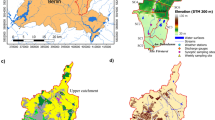Abstract
The study aims to assess the performance of the Revised Universal Soil Loss Equation (RUSLE) model at Mediterranean mountainous catchments. To that end, it was implemented at three mountainous catchments (seven subcatchments in total) of NW Greece (Kalamas; Upper Acheloos; Arachthos Rivers), both annually and inter-annually, using a GIS-based delineation. Its performance was validated against simulated sediment yield values, estimated considering the sediment discharge rating curves methodology (based on the simultaneous discharge-sediment discharge measurements conducted by the Greek Public Power Corporation-PPC). At the inter-annual time scale, the model performed exceptionally well at Avlaki Dam and Tsimovo Bridge subcatchments, attributing almost identical results (slightly overestimated), while at all other subcatchments behaved inconsistently (significant overestimation at the Gogo Bridge subcatchment; underestimation at the Soulopoulo Bridge, Kioteki, Arta Bridge and Plaka Bridge subcatchments). Annually, the model performed similarly at Soulopoulo Bridge, Kioteki, Arta Bridge, Plaka Bridge, Gogo Bridge subcatchments, while at Avlaki Dam and Tsimovo Bridge its performance was inconsistent throughout the years. This was mainly due to the questionable quality of the simulated sediment yield values, along with the model’s inherent limitations and the specific characteristics of the study area. Overall, the model performed quite well, successfully identifying the high risk erosion areas.











Similar content being viewed by others
References
Asselman NEM (2000) Fitting and interpretation of sediment rating curves. J Hydrol 234:228–248
Bosco C, Rusco E, Montanarella L, Panagos P (2009) Soil erosion in the Alpine area: risk assessment and climate change. Studi Trent Sci Nat 85:117–123
DHI (1999) SEAGIS 1.0: Documentation and user’s manual
Efthimiou N (2016) Developing strategies for estimating sediment yield by using Decision Support Systems at mountainous hydrological catchments. Dissertation, Agricultural University of Athens (in Greek)
Efthimiou N, Lykoudi E, Karavitis C (2014) Soil erosion assessment using the RUSLE model and GIS. Eur Water 47:15–30
Ferguson RI (1986) River loads underestimated by rating curves. Water Resour Res 22(1):74–76
Fox DG (1981) Judging air quality model performance. A summary of the AMS workshop on Dispersion Model Performance. Bull Am Meteorol Soc 62:599–609
Hrissanthou V, Pyliotis A (1995) Estimation of sediment inflow into a reservoir under construction. 6th Conference of the Greek Hydrotechnical Union, Thessaloniki, Greece, pp 355-362 (in Greek)
Koutsoyiannis D (2000) Broken line smoothing: a simple method for interpolating and smoothing data series. Environ Model Software 15:139–149
Koutsoyiannis D, Tarla K (1987) Sediment yield estimations in Greece. Technica Chronica A-7(3):127–154 (in Greek)
Lykoudi E, Zarris D (2002) Identification of regions with high risk of soil erosion in the island of Cephalonia using the Universal Soil Loss Equation. Proceedings of the 6th National Conference of the Geological Society of Greece, Thessaloniki, Greece, Volume II, pp 412–419 (in Greek)
Lykoudi E, Zarris D (2006) Assessment of hydrologic catchments’ sediment yield by comparative analyses of hydrologic and geomorphologic parameters. Framework program of basic research “PROTAGORAS”, National Technical University of Athens (in Greek)
Nash JE, Sutcliffe V (1970) River flow forecasting through conceptual models, I. A discussion of principles. J Hydrol 10(3):282–290
Panagos P, Meusburger K, Ballabio C, Borrelli P, Alewell C (2014) Soil erodibility in Europe: a high-resolution dataset based on LUCAS. Sci Total Environ 479–480:189–200
Panagos P, Borrelli P, Meusburger C, Alewell C, Lugato E, Montanarella L (2015) Estimating the soil erosion cover-management factor at European scale. Land Use Policy J 48(C):38–50. doi:10.1016/j.landusepol.2015.05.021
Poulos SE, Chronis GT (1997) The importance of the river systems in the evolution of the Greek coastline. In: Transformations and evolution of the Mediterranean coastline, Bulletin de l’ Institute Oceanographique, Monaco, 18:75–96
Renard KG, Foster GR, Weesies GA, Porter JP (1991) RUSLE: revised universal soil loss equation. J Soil Water Conserv 46(1):30–33
Renard KG, Foster GR, Yoder DC, McCool DK (1994) RUSLE revisited: Status, questions, answers, and the future. J Soil Water Conserv 49(3):213–220
Renard KG, Foster GR, Weesies GA, McCool DK, Yoder DC (1996) Predicting Soil Erosion by Water: A Guide to Conservation Planning with the Revised Universal Soil Loss Equation. Agriculture Handbook No. 703, US Department of Agriculture, 384pp
Renfro GW (1972) Use of erosion equations and sediment delivery ratios for predicting sediment yield. In: Proceedings of the sediment yield workshop: Present and prospective technology for predicting sediment yield and sources, USDA Sedim Labor, Oxford, Mass USA, pp 33–45
Schwertmann U, Vogl W, Kainz M (1990) Soil erosion by water. Verlag Eugen Ulmer, Stuttgart (in German)
Sigalos G, Loukaidi V, Dasaklis S, Alexouli-Livaditi A (2010) Assessment of the quantity of the material transported downstream of Sperchios river, central Greece. Bulletin of the Geological Society of Greece, Proceedings of the 12th International Congress, Patras, Greece
Van der Knijff JM, Jones RJA, Montanarella L (2000) Soil erosion risk assessment in Italy. EUR 19044 EN, Office for Official Publications of the European Communities, Luxembourg, 44pp
Walling DE (1977) Assessing the accuracy of suspended sediment rating curves for a small basin. Water Resour Res 13(3):531–538
Willmott CJ (1981) On the validation of models. Phys Geogr 2:184–194
Wischmeier WH, Smith DD (1978) Predicting rainfall erosion losses: a guide to conservation planning. Agriculture Handbook No. 537, US Department of Agriculture, US Govt Printing Office, Washington DC, 58pp
Wischmeier WH, Johnson CB, Cross BW (1971) A soil erodibility nomograph for farmland and construction sites. J Soil Water Conserv 26(5):189–193
Zarris D, Koutsoyiannis D (2005) Evaluating sediment yield estimations from large-scale hydrologic systems with the rating curve concept. RMZ-Mater Geoenviron 52(1):157–159
Zarris D, Lykoudi E, Panagoulia D (2007) Sediment yield estimates in North-Western Greece and analyses with hydrologic and geomorphologic factors. Proceedings of the 11th International Congress, Geological Society of Greece, Athens
Zarris D, Vlastara M, Panagoulia D (2011) Sediment delivery assessment for a transboundary Mediterranean catchment: the example of Nestos river catchment. Water Resour Manag. doi:10.1007/s11269-011-9889-8
Author information
Authors and Affiliations
Corresponding author
Rights and permissions
About this article
Cite this article
Efthimiou, N. Performance of the RUSLE in Mediterranean Mountainous Catchments. Environ. Process. 3, 1001–1019 (2016). https://doi.org/10.1007/s40710-016-0174-y
Received:
Accepted:
Published:
Issue Date:
DOI: https://doi.org/10.1007/s40710-016-0174-y




